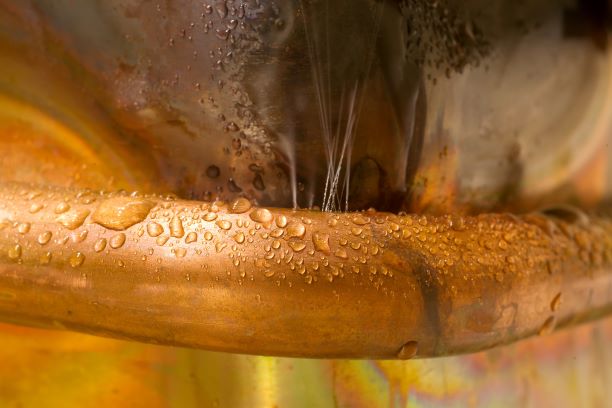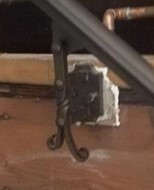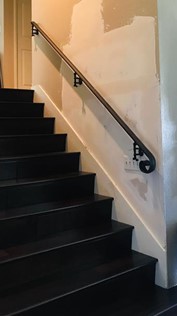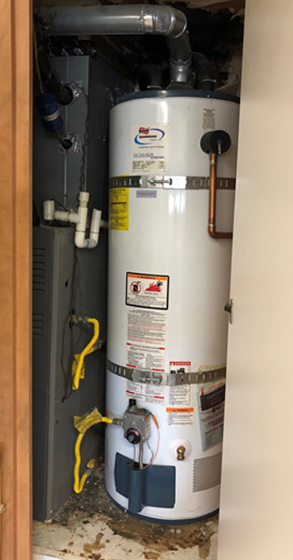
Water Leaks and Water Damage Detection

Many water leaks can be detected before water damage repairs become a major issue. At some point most homeowners or renters will experience a water leak in their home. Sometimes the source is obvious. All too often hidden water leaks later become major damage repairs. Water damage usually leaves a telltale sign that there is a leak somewhere. If we know what to look for, this awareness can save thousands of dollars in preventative repairs.
Five years earlier, this homeowner had custom stair railings installed. The installer had driven a screw into the hot water pipe leading to an upstairs shower. This is how a hidden water leak became a major repair over the next five years.
Water leaked down the shower pipe into the stair wall and under newly-installed wood flooring on the stairs. Over time, water seeped down into the entryway landing. It spread under the landing into the lower level of the home. Spreading across the hallway, it crept up the opposite kitchen wall and into that flooring. Seepage also destroyed the ceiling and platform base holding the A/C unit and water heater closet one floor below the leak. The base shared a wall with a sizable pantry and the garage ceiling. Water damage repairs were in the thousands of dollars.
Could this leak have been detected sooner? Absolutely.

There were other, obvious signs the homeowner missed., such as bubbling paint on the stairway wall. Worse, the homeowner noticed the wooden flooring below the entryway landing began to ‘squish’ underfoot, like walking on a waterbed. The homeowner assumed the wood flooring was de-laminating from the tile base and that the squishy feel was caused by air instead of water. The hidden water leak had become a major repair.
Closer examination revealed a very faint, soggy, bubbling in walls above the baseboards. The dark wood flooring had even darker stained patches. After ruling out the A/C unit and water heater as potential culprits, with these other indicators the plumber traced the leak to pipe in the upstairs wall.
Finding Hidden Water Leaks
What to Inspect First, and Types of Water Damage to Look For

Begin with knowing what to inspect to find hidden water leaks, and signs of water damage you should look for. Many water leaks occur around failed mechanical systems in homes. In this case, the homeowner would have seen that there was water damage occurring above and below these systems. Evidence included a blackened, significantly damaged ceiling and rotting base of the water heater closet.
- Take a close look at your water bill. If your usage has increased, you may have a leak.
- Inspect areas around older appliances, your water heater, and HVAC system.
- Check around toilet bases, under sinks, and inside cabinets.
- Remember to check outside faucets and test your sprinkler systems.
Your water bill can alert you to leaking systems. However, other leaks may be occurring during heavy rain. During rains are the best time to inspect indoors and under covered, exterior living spaces.
- Inspect wall surfaces, looking for areas where the paint appears bubbled, or the surface has a soft, crumbly texture.
- Discoloration, peeling or flaking paint around windows, doors, and fireplaces may indicate a flashing or siding needs caulking or replacement.
The squishy floor should also have been a huge red flag for this owner, coupled with darker wet patches. Visual inspections of ceilings and lower walls would have revealed a hidden leak before water began seeping into adjoining areas.
More obvious cases of water damage due to hidden leaks can be avoided with routine maintenance to reduce risk. A leaky roof, poor drainage, and clogged gutters or downspouts can lead to significant water damage inside a home and extend to a roof or siding. Schedule roof and downspout cleaning to remove accumulated leaves, twigs and other debris that prevent proper drainage. Trim trees regularly to prevent contact with the roof during high winds.
Water intrusion from storms or other damage should be addressed immediately. Exposing and completely drying all wet areas by providing air circulation can aid in the drying process. Exposed exterior areas of the dwelling should be covered with a tarp to prevent further water intrusion. Covering exposed areas. Drying and dehumidifying wet areas can help minimize the possibility that mold will form due to sustained intrusion. Remove any furniture that is standing in water.
Homeowners Insurance and Flood Insurance
Two Different Insurance Policies That Cover Two Types of Water Damage
In a condo where the leak may affect adjoining units, read more here, about Condo Leaks: What to Do, and Who to Call.
Homeowners and Flood Insurance policies provide two different types of coverage that complement each other, but do not overlap. A homeowners’ policy does not protect against flood damage.
Homeowners’ Insurance. Most policies cover damage to your home caused by an accidental water event. This may include a burst pipe, or wind- or storm-driven water intrusion. Water damage caused by poor maintenance or neglected leaks are not generally covered by insurance. Exclusions might include clogged gutters, a poorly maintained roof, or condensation buildup due to inadequate ventilation.
Flood Insurance. A separate flood insurance policy is available through the National Flood Insurance Program from the Federal Emergency Management Agency (FEMA). This insurance is available to homeowners and renters, for both personal and commercial properties, and is usually effective within 30 days of purchase. The cost of insurance varies, depending on the amount of insurance purchased, selected coverage, and a property’s flood risk.
There should be a toll-free claims number on your insurance policy. Most companies will also require that you notify them in writing describing what has occurred.
The following tips can help the claims process go more smoothly:
- Review your policy to ensure you understand what’s covered and what isn’t. If you’re not sure, ask your agent to explain.
- Have your policy number ready before you call the insurance company and be prepared to answer questions about the damage.
- Photograph or videotape damaged areas and personal property before you make repairs, of damage areas before the insurance adjuster inspection.
- Store all personal items you removed from the dwelling until your insurance adjuster has seen them.
- Make reasonable, necessary repairs to prevent further dwelling and property damage. Don’t make large structural or permanent repairs until the insurance company approves these.
- Keep a record of all personal repair expenses, with associated receipts.
- Keep a log that lists everyone you spoke with at your insurance company and, if applicable, your HOA’s management company. Note the time, date, name of the person, and what was discussed. Confirm important details in writing, and preserve copies of all written communications.
Protecting Your Home
How to Prevent Water Leaks and Mitigate Damage
Protecting your home from water damage can cost thousands of dollars in losses and repairs. These are almost never covered by standard homeowners insurance. Industry expert Water Damage Defense claims that “75 percent of water heaters fail before they are twelve years old… Approximately 14,000 homeowners a day experience water damage at an average cost of almost $7,000 per claim.”
75 percent of water heaters fail before they are twelve years old…
–Water Damage Defense, Industry Expert
and approximately 14,000 homeowners a day experience water damage at an average cost of almost $7,000 per claim
Inspect your home regularly for hidden water leaks that leave signs and sources of moisture and leakage. After rain, check for water stains in your ceilings, walls, and around windows. Create a maintenance schedule to check the following sources of water leaks on a regular basis. Contact a service company with any questions or concerns:
- Hot water heaters. Hot water heaters may rust or develop cracks over time. Check annually for rust and deterioration. Check the drain pan for water and ensure that the drain line for the overflow pan is not clogged. Drain and clean the water heater as recommended by the manufacturer.
- Garbage disposal. Routinely check for cracks or other sources of leaks.
- A/C drain lines. Damage can occur when the line that drains condensation from the evaporator coils becomes clogged and water overflows from the drip pan. Periodically check the drip pan for water and consider an annual service call to reduce the buildup of algae and mold in the drain line.
- Indoor and outdoor pipes and faucets. Routinely check indoor pipes and sinks, and lower interior cabinets for evidence of leaks, rust, or any signs of deterioration. Minimize the potential for water damage from frozen and broken outdoor pipes by insulating supply lines (in attics, crawlspaces, and exterior walls), protecting exposed outdoor faucets, sealing gaps in exterior walls, and maintaining adequate heat in your home.
- Appliance hoses. Broken hoses are among the most common causes of water damage. Regularly inspect hoses and hose fittings on washing machines, ice makers, and dishwashers for kinks, cracks, bulges, or deterioration. Replace standard rubber washing machine hoses every two to five years, or more often if they are showing signs of wear. Consider using steel-reinforced hoses for longer life.
- Showers, tubs, sinks, toilets, windows, and doors. Water leaks around bathtubs, showers, sinks, and toilets can cause damage because the leak is often not readily visible. Make sure you have a watertight seal of caulk around tubs, sinks, toilets, tubs, shower stalls, windows, and doors. Cracks or mold on caulk or tile grout may indicate that you don’t have a watertight seal. Remove all old caulk or grout, clean and dry the surface thoroughly, and apply fresh caulk. Don’t apply new caulk or grout on top of the old materials.
- Attics and ceilings. Routinely check for wet insulation and water stains.
- Wallpaper. Check for bubbling, peeling, and water stains.
- Roofs. Debris buildup can damage roofing and allow water to seep in. Trim tree branches to prevent them from coming in contact with the roof. Repair missing or damaged shingles or tiles. Seal cracks around chimneys, skylights, and vents. Check metal flashing for holes, cracks, or other damage. Replace flashing or use silicone caulk to seal any openings.
- Rain gutters and downspouts. Direct rainwater away from your home. Keep gutters clear and ensure downspouts extend long enough to carry water away from your foundation. Gutters filled with leaves and other debris allow water to pool on the roof, resulting in water damage to eaves and roofing material.
- Sump pumps. Sump pumps are the first line of defense in preventing water from seeping into basements. Periodically check the sump and remove any debris that could clog the pump. Consider installing a battery-powered backup to protect your basement during power outages.
- Weep holes. Weep holes are openings at the foundation level of a brick wall that allow moisture to escape from behind the wall. Don’t close or block these openings.
- Landscape. Yards should slope away from the house to prevent puddling near the foundation or under pier and beam houses. Don’t allow sprinklers or sprinkler heads to soak the exterior of your house. French drains around the perimeter of your home can eliminate pooling.
- Hydro Jetting. Depending on the age and condition of the pipes, buildings with common area drain lines should consider having their lines jetted periodically. Sometimes sewer pipes can become extremely clogged by debris, or by root systems that have invaded plumbing. In such circumstances, hydro jetting can remove blockages that traditional techniques cannot clear.
- Water Cop. Water Cop is an automatic water shut-off system that provides your home with round-the-clock indoor flood protection. It works with wired and wireless flood sensors, wall switches, and most home security and home automation systems.
More To Know About Leak and Damage Prevention
- The location of water valves, including where the main valve is located and how to turn the water off.
- Monitor utility bills. An unusually high water bill could signal a water leak.
- Turn your water off before traveling. Turn the water off at the main valve or directly on major appliances.
- Consider leaving a house key and contact information with a neighbor or trusted friend and ask the person to check the inside and outside of your home periodically while you are away.
© 2019 | ASPM-SanDiego℠ All Rights Reserved.
